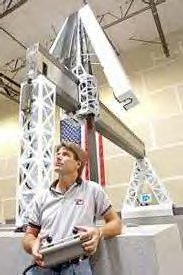The calibration device created in Tempe will be used to
measure and perfect the 180 panels that will make up the
telescope's huge dish.
The CMM machine will scan each panel from left to right
and from top to bottom, gathering 20 million data points,
comparing them with the desired dimensions and figuring which
of the panel's 270 adjusters need to be tweaked by hand.
It will repeat the process three or four more times, on
all 180 panels, before they are installed on the telescope.
The measurements are a critical step in the
construction of the Large Millimeter Telescope/Gran Telescopio
Milimetrico, a joint project between the University of
Massachusetts at Amherst and Mexico's National Institute of
Astrophysics, Optics and Electronics. Scheduled to begin
operating by early 2005, it is designed to detect radio waves
from distant stars and galaxies.
Without the Resource Engineering Inc. machine's
intensely accurate measurements, scientists say, incoming
radio waves would bounce off the panels in the wrong
directions and go uncollected by the telescope's computers.
"This has to be accurate to within the thickness of a
sheet of paper," said Allan Langord, project manager with the
University of Massachusetts.
Major companies said they couldn't do such
measurements, he said, but Resource Engineering's creative
engineering and attention to detail has brought its part of
the project in on time and beyond expectations.
Resource Engineering designs and builds ultra-accurate
positioning systems "that no one else can or wants to build,"
Tim Swift said. The three principals, mechanical engineer
Swift, electronics engineer John Hunter and software guru Paul
Keeling, do only a dozen or so projects a year.
The three met when they worked at a competing machine
tool company that moved from the Valley. Resource Engineering
was born eight years ago when clients began calling Swift's
home and offering him contracts for custom projects if he
would put the team back together.
Though small, the company has built measuring machines
for General Electric Co.'s power generation division and is
building two ultrasonic scanners that Lockheed-Martin Corp.
will use to test parts for the next-generation of F-22
fighters.
Being a small company forces team members to wear many
hats during each project, Swift said, giving them the chance
to improve their technology each time.
"I lay awake at night hoping . . . that the radio
telescope has 'first light' and that no F-22s have structural
defects," Swift said.
The firm got the telescope job after answering a
University of Massachusetts request for proposals and passing
review from a panel of experts in measurement science.
"Only a handful of companies in the world are capable
of building a CMM for that size and accuracy," said Steven
Phillips, a program manager with the National Institute of
Standards and Technology who helped review proposals.
Resource Engineering got the contract in March 2001,
moved to a warehouse big enough to handle the project, and
began work.
It has taken 12- to 14-hour days, seven days a week,
for the team to build the machine that measures 22 feet high,
16 feet wide, 25 feet long and weighs 110,000 pounds. Two
slabs of New Hampshire granite form the base and support the
frame for a giant beam, from which hangs the laser-tipped arm
that will measure the telescope's panels.
One of the key challenges to the project was building a
frame that would not expand or contract with changes in
temperature, because that would throw off the measurements. So
they used Resource Engineering's patented structure combining
carbon fiber - the strong, stiff material popular in aerospace
and sporting goods - and Invar, a temperature-resistant alloy
of steel and nickel first developed for Swiss watches.
Building the crossbeam was another challenge. No one
had ever built a carbon fiber-Invar beam that long, Swift
said, and other companies doubted the material would scale up.
Swift tweaked the design and got it to work the first time.
Resource Engineering also had to develop the
panel-measurement software. It all came together last month,
when the device passed preliminary tests and was approved for
shipment.
The machine will be shipped this summer to the U.S.
Embassy warehouse in Laredo, Texas, where crews from the
Mexico side of the project will escort it to the telescope
site in Puebla state. Swift will fly down and install it, in
preparation for volume production of the panels this fall.

